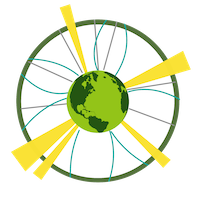Speaker
Description
This work studies the interaction of cosmic rays, extraterrestrial particles with energies ranging from 10⁶ eV to 10²⁰ eV, which produce secondary particles, including neutrons, when they collide with atmospheric molecules. These neutrons can be used to non-invasively estimate soil moisture through cosmic ray neutron sensors (CRNS), opening the possibility of using this technology in precision agriculture monitoring systems to optimize the use of water and other agricultural resources. To calibrate CRNS, the MEIGA framework was developed to simulate neutron transport from the top of the atmosphere to 2 km altitude over different observation levels, ranging from sea level to 5000 m a.s.l. The resulting neutron and gamma-ray spectra at ground level were obtained. The results show that the cosmic neutron flux increases with altitude and that the photon spectrum generated by ground interactions can be observed over an area of 1.68 ha. With the capability to calculate the surface neutron flux based on the geographical position (altitude, latitude and longitude), the MEIGA framework facilitates the implementation of CRNS in different regions of the world. This type of technology contributes to more efficient water management in agriculture and supports climate change adaptation strategies.

